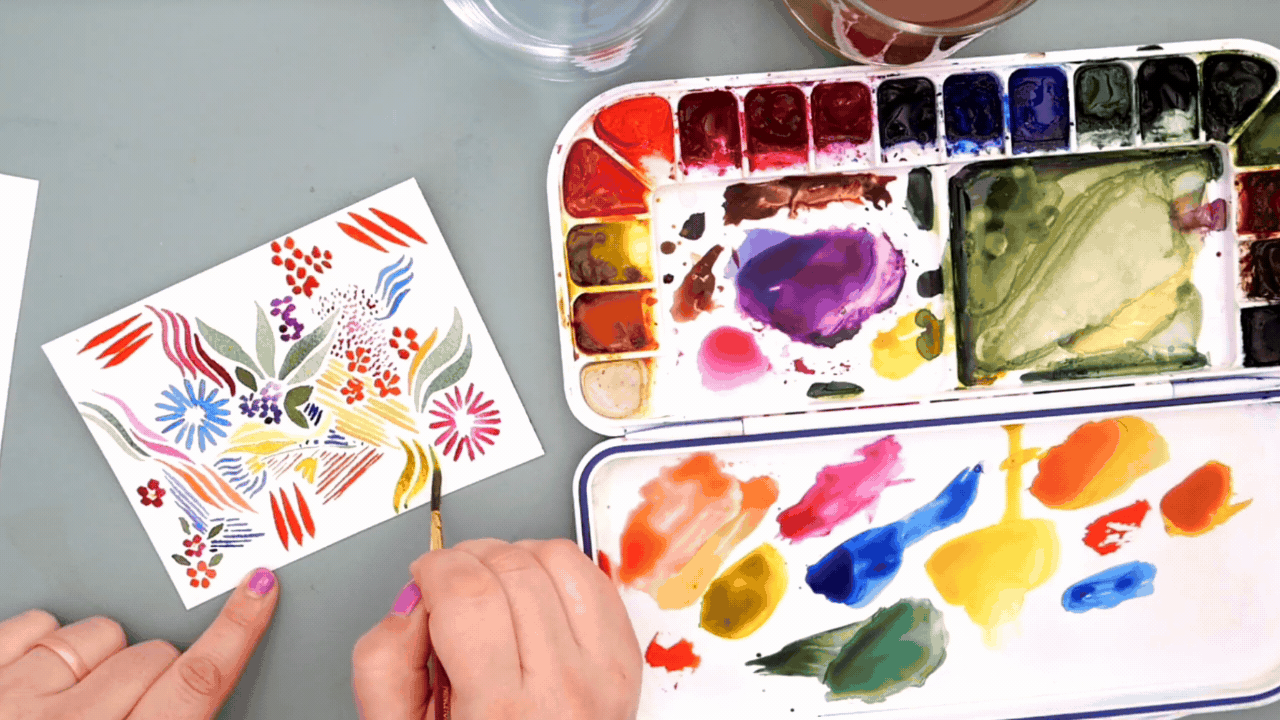Watercolor Mark-Making for Relaxation
Watercolor can be such a fun and relaxing medium for creatives, but I know that sometimes it can feel a little daunting. If you’ve ever felt intimidated by the blank page, this tutorial is for you! In the blog below, we’re going to walk through a fun and relaxing watercolor exercise that will get you painting and making marks as you get into a creative flow.
What is mark-making, you ask? It’s exactly what it sounds like – making marks on paper! Think of it as watercolor doodling. It doesn’t have to be anything fancy. This is just a way to explore, experiment with your supplies, and tap into your creativity. This is an exercise that is designed to be relaxing, but it can also help you get unstuck if you’re experiencing painting paralysis. It’s a low-pressure way to create something and enjoy the act of putting brush to paper!
Here’s an example of a watercolor doodle I did recently on a call with the members inside The Garden Studio.
We all painted colorful marks together and then we had a painting exchange. Members sent their paintings in and received someone else’s painting in exchange. Fun, right? (Side note: next time I’ll be having the members exchange them directly with each other, because my kitchen table had a couple hundred beautiful paintings on it at one point and the logistics were a little tricky!)
I’ll go through some of the marks I made and how you can create your own later in this post, but first I want to chat with you about the benefits of being creative simply for the sake of being creative. That can be hard for anyone, but especially for recovering perfectionists like me, so if you’ve struggled with putting pressure on yourself to create or with the negativity that can accompany perfectionism, I think you’ll enjoy mark-making!
The Benefits of Mark-Making
Benefit #1: Learn about your supplies
First, you’ll learn a ton about your watercolor supplies. From exploring the different colors in your palette to seeing what kinds of marks you can make with different brushes, this exercise is going to help you get comfortable with your supplies, which is one of the first steps to feel truly confident when painting.
Benefit #2: Relaxation and creative flow
The best part about mark-making is that it can be pretty loose and abstract. You’re not trying to create a masterpiece or a realistic rendering of a complicated flower. Instead, it’s all about slowing down and tapping into the joy of watercolor. I don’t know about you, but I started making art because it’s fun and relaxing! This is a way to connect with the sense of peace and happiness that painting can bring without any pressure.
Benefit #3: Mark-making as a painting warm up
Mark-making can also be a great warm up for your painting session. Athletes warm up to make sure that they can perform their best on the field (this is the last sports analogy I’ll use, I promise 😂). And just like an athletic warm up, a painting warm up can help you “perform” better during your painting session.
You know what they say – paint is only wasted if it stays in the tube (or palette in our case). It may seem like a waste to use your good supplies on a watercolor doodle, but don’t be afraid to use your supplies to create a page of marks. It could very well turn out to be gorgeous! And even if it’s not something you’ll want to hang on your wall, you’ll definitely learn something along the way.
Ready to create a fun page of relaxing doodles? Let’s dive in!
Watercolor Mark-Making 101
There is no “right” way to create your page of watercolor marks. This is your time to explore and find what feels fun! I’m going to share a few different techniques and types of marks to help you get started, but feel free to take your painting in whatever direction feels best to you!
Dot flowers
As a botanical watercolor teacher, I always want to include some flowers in my paintings! If that appeals to you, try making cute little dot flowers like these to start filling up your page. To be honest, you could fill the entire paper with only these little flowers in different colors and it would be beautiful!
Stamped flowers
Another fun and easy technique for painting flowers in watercolor is to use your brush as a stamp. Stamp it down and rotate the page to get a flower full of fun stamped petals! This is another great way to explore the different types of brushes you have. This would look completely different with a filbert brush, for example.
Leaves
Your doodled flowers wouldn’t be complete without a few leaves! Add some near your flowers to give it a fun abstract floral look. Bonus: this is a great way to practice painting leaves for your full watercolor floral compositions.
Explore different kinds of lines
I love using different kinds of lines to fill the whitespace on my page. In my example I explored using thin lines, wavy lines, lines using different pressure on the brush, small dashes, and more! The only limit is your imagination!
Fill the page and whitespace
Once the main motifs are painted, I think it’s really relaxing and fun to fill up the entire page. I try to fill up all the whitespace with different dots and lines without overlapping any of them. This is where you can really get into the zone and I just love seeing the entire page filled with happy little marks!
I hope you enjoy this relaxing watercolor exercise! If you want to learn more about watercolor painting, check out my FREE watercolor eBook where I share everything you need to know to get started with watercolor. It includes my favorite supplies, techniques, and so much more!
Happy painting,
Alex








